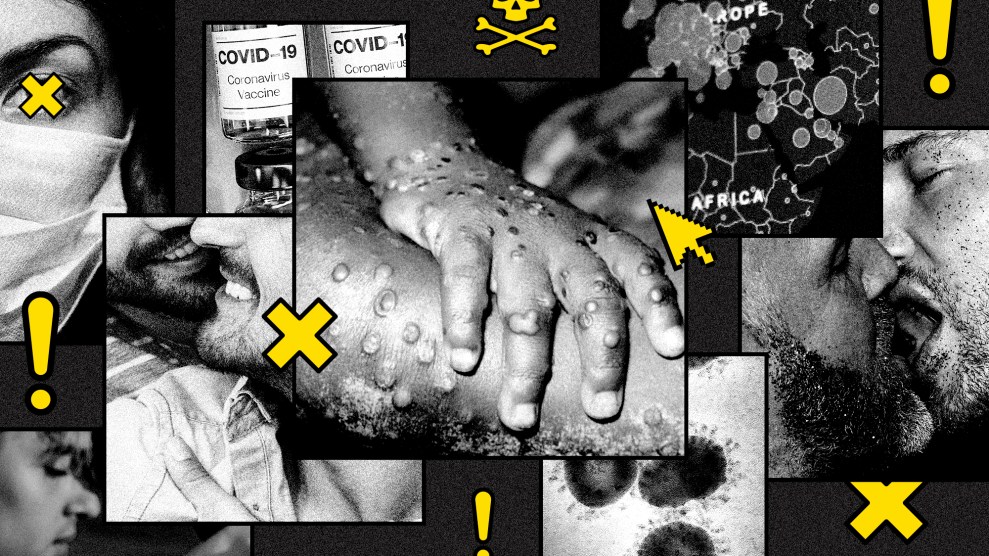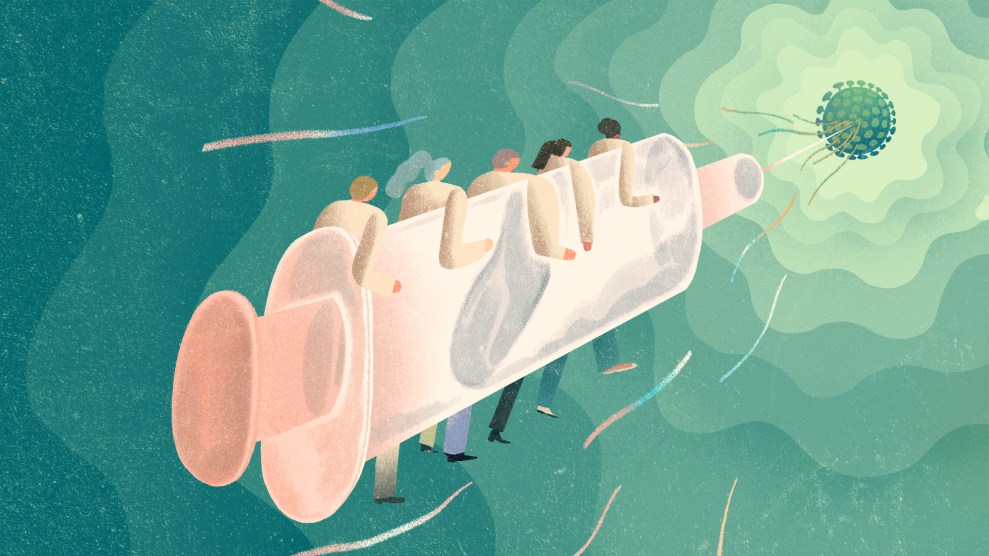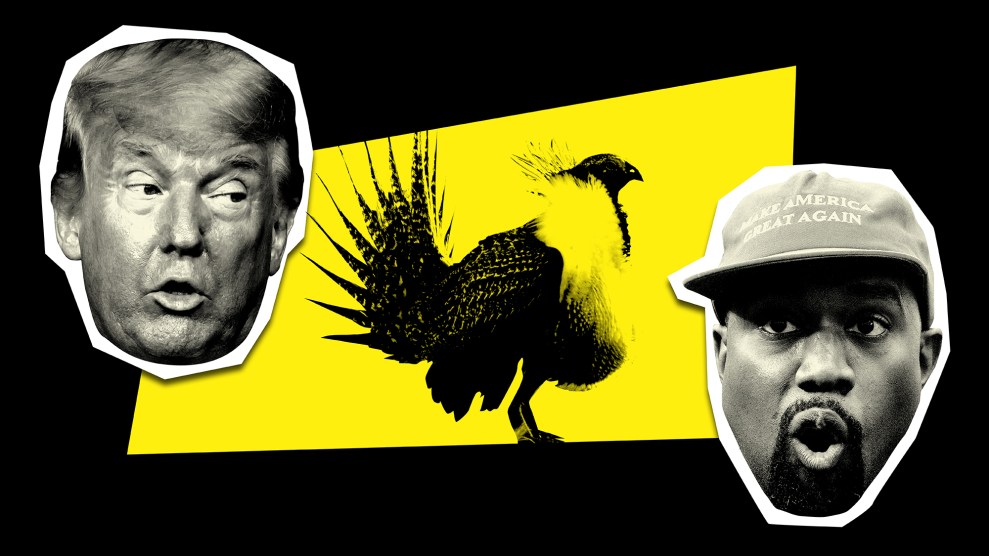On May 15, 2020, a US-bound cargo plane was scheduled to depart Mauritius, an island about the size of Maui that’s just east of Madagascar. There were four key things I knew about the flight:
- It involved the transportation of monkeys.
- The monkeys were intended for Covid research.
- The cost—to cover the fuel, crew, insurance, and other expenses—totaled nearly half a million dollars.
- The public was never supposed to find out about it.
In a backward sort of way, the only reason I can tell you anything about the flight is because it never happened.
For more articles read aloud: download the Audm iPhone app.
The deal involved two companies, both of which could not have sounded more unimportant: an air carrier called Skybus Jet Cargo and a Delaware-based firm, International Logistics Support, which had arranged the flight. But, ultimately, the deal between the two companies fell through. The plane never took off. And shortly after, International Logistics Support sued Skybus for damages in a Miami court. With the resulting 300-plus pages of court documents, I was able to piece together these basics.
Still, there were big holes in the picture. For instance, who purchased the animals? How many were there? What species? (My best guess was long-tailed macaques, which are commonly sourced from Mauritius.) Where—which lab or labs—were the monkeys supposed to end up? And why, exactly, didn’t the flight take off as planned?
So I kept digging. I read everything I could find about the case. I submitted public records requests to the Centers for Disease Control and Prevention, the National Institutes of Health, the Fish and Wildlife Service, and the United States Department of Agriculture, all of which oversee nonhuman primate trade, transport, and research. I asked animal rights groups, government officials, and academics if they had any information about the case. I reached out to the companies involved, only to conduct a series of fairly fruitless interviews with the owner of International Logistics Support, a guy named Matthew Block, who, it turns out, is something of an infamous character among animal rights groups. From nearly everyone else? Crickets.
Navigating the monkey business, I learned the hard way, is a bit like navigating a, well, jungle.
But my digging took me far beyond this singular flight. The Skybus case, in fact, offers a rare glimpse into the wider trade of monkeys—a famously secretive industry—during the worst health crisis in a century. In the records I was able to find, in the conversations with the few people who were willing to talk, and in the history I was able to mine, the details surrounding the flight pointed to a much bigger story: Primate research is in trouble. And the dilemma it is facing has very real, very urgent, very human stakes.
Due to a combination of factors—including a complete shutdown of primates being exported from China, an insufficient monkey reserve in the US, ongoing opposition from animal rights groups, and, of course, the Covid pandemic—the country is in the midst of a years-long monkey shortage. To put it simply, researchers say the supply of animals can’t keep up with the demand. In 2019, the US imported nearly 34,000 monkeys, about 60 percent of which came from China. After China closed off primate exports the following year, the total number dropped to less than 27,000—a 21 percent decline—and the price for a single macaque reportedly doubled to nearly $10,000 in early 2020, and has since risen to as much as $20,000. Without a reliable supply of monkeys, researchers are going to greater lengths to advance their work—paying more for primates, importing younger animals, “recycling” monkeys more often, and sourcing them more heavily from other locations, like Mauritius. For years, Block tells me, the US largely ignored calls to expand its own monkey colonies: “Now we’re paying the price.”
Believe me, I wish biomedical research had a better substitute for testing on our closest animal relatives. And one day, it might. But no matter how you or I feel about it, it’s clear the practice has saved—and is saving—human lives. If you received a shot of the Covid vaccine, for instance, you have monkeys to thank for it; before their vaccines were released to the masses, Pfizer, Moderna, and Johnson & Johnson trialed them in monkeys first. The same is true for Covid treatments like monoclonal antibodies or the antiviral remdesivir. Monkeys were also instrumental in testing vaccines that can protect against monkeypox.
And so the monkey shortage is putting human lives at risk. Scientists say vital medical and scientific studies have been delayed or prevented entirely, leaving us ill-prepared to keep fighting this pandemic, not to mention future ones. “It’s a threat for bio defense. It’s a threat for our economy. It’s a threat for our standing in research,” says Joyce Cohen, the associate director of the Division of Animal Resources at the Yerkes National Primate Research Center housed at Emory University. “All these things are hugely important.”
Nevertheless, much like the individuals involved with the flight, many of the people affected by the shortage—breeders, pharma employees, scientists—were hesitant to talk about it, ignored my interview requests, asked to remain anonymous, or were generally cautious about how they described their work. Some cited fear of retaliation from animal rights groups, others had concerns about confidentiality. The irony is, talking about the problem—and educating the public about primate research more broadly—may be exactly what’s needed to help address the shortage itself.
It’s these factors that make the May 2020 flight more complicated—and more intriguing—than a simple contract dispute. According to Block, he and his unnamed client eventually got their shipment of monkeys delivered to the US, though it “slightly delayed research programs for COVID,” he tells me in an email. So while I can’t tell you the lab ID numbers of those monkeys, or the trials they likely participated in, I can tell you the history and context of the environment to which they arrived, and what the hell a plane full of monkeys set to fly across the Atlantic says about the state of science in America.

If there is a singular starting point to modern primate research, it is arguably 1908. At the time, two Austrian scientists studying polio had tried, unsuccessfully, to infect rabbits, mice, and guinea pigs with the disease. Then, they injected two monkeys, a baboon and a rhesus macaque, with a sample of spinal cord taken from a 9-year-old boy who’d died of a severe polio infection. Like human polio patients, both monkeys developed symptoms; the rhesus macaque lost function in both of its legs. While gruesome, the discovery eventually led to the release of the polio vaccine in 1955—and decades of primate research since.
By the late 1950s, primate research in the US had officially taken off, and the country was importing more than 200,000 monkeys per year, largely from India, writes science journalist Deborah Blum in her 1994 book The Monkey Wars. The numbers stayed steady through the early 1960s, with more than 100,000 animals imported on an annual basis. “Rhesus macaques were numerous then,” she writes, “so much so that they virtually could be shoveled out of the jungles of India.” Today, US monkey imports are much lower, hovering between about 20,000 and 30,000 animals per year.
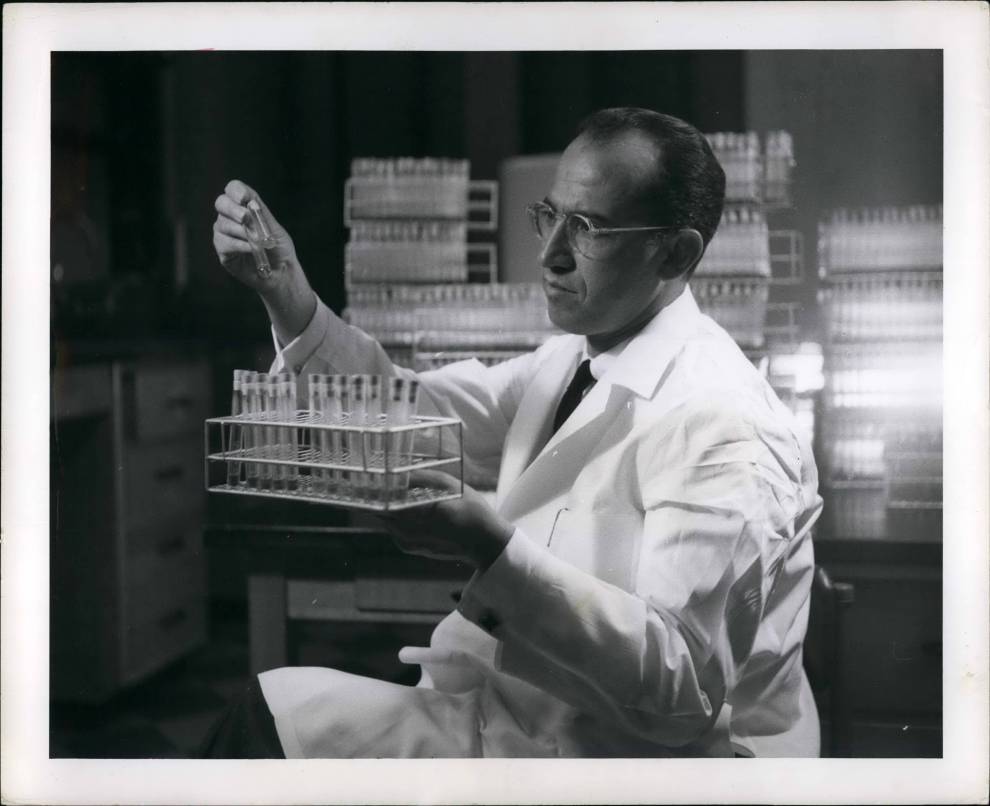
Dr. Jonas E. Salk in 1954. Salk developed one of the first successful polio vaccines, which was tested on monkeys.
Keystone Press Agency/Zuma
Particularly for academic labs, the rhesus macaque is among the most studied monkey. They’re about the size of a small dog, brownish gray in color, with a naked, pink face. (As a species, they like to keep their distance from humans—unlike, say, mangabeys, “they’re not loving cuddly, cute little monkeys,” Blum tells me, and can carry a Herpes-like virus called B virus.) Part of what makes the rhesus macaque a popular choice, however, is its genes: It shares 93 percent of its DNA with us, and is susceptible to many of the same diseases, including a virus similar to HIV. And unlike many other species, rhesus monkeys menstruate, making them good candidates to study reproductive health. Its close relative, the long-tailed macaque, is also widely used for pharmaceutical testing in part because it is smaller, and therefore less expensive to house. Of all the monkeys imported into the US in the last three years, the vast majority were long-tailed macaques.
Primate research is mostly iterative, and “breakthroughs” are usually years, if not decades in the making. Some of these advancements include anesthesia, chemotherapy, blood transfusions, cortisone shots; the discovery of lead poisoning and the effects of secondhand smoke; deep brain stimulation as a treatment for Parkinson’s; drugs that help with organ transplants, treat leprosy, lupus, depression, diabetes, and prevent HIV infection; vaccines for yellow fever, measles, mumps, and rubella, hepatitis, anthrax, Covid-19; and so much more.
But, as with polio, many of these life-saving discoveries wouldn’t have been possible without taking the lives of animals. And from the very beginning of this research, there were those who loudly opposed it on ethical grounds. “There were animal activists busy on this continent before there was even a United States of America,” Blum writes in The Monkey Wars; Puritans in Massachusetts established a law against animal cruelty back in 1641. During the 19th century, “as rising industrialization drove concerns for civil liberties and oppression,” Blum writes, animal activists formed into groups, including the American Society for Prevention of Cruelty to Animals (ASPCA) and the American Anti-Vivisection Society, which opposed operation on live animals. As biomedical research and animal testing progressed into the 1900s, so too did opposition from animal welfare groups—a reality that has undoubtedly shaped today’s research.
The modern animal rights movement really gained momentum in the second half of the 20th century, following a series of high-profile primate laboratory incidents. As Blum reports, one of the most recognized of these incidents took place in Silver Spring, Maryland. The story goes like this: In 1981, 23-year-old Alex Pacheco volunteered to join a lab at the Institute for Behavioral Research, where scientists were studying, among other things, nerve damage in monkeys. Under the guise of an eager student, Pacheco—who had recently co-founded People for the Ethical Treatment of Animals (that is, PETA)—documented some alarming details: monkeys with infected, gnawed limbs, minuscule cages, dead animals in the freezer. Later that year, the lab’s top scientist was convicted and fined under a Maryland anti–animal cruelty law. (Those charges would eventually be overturned, but in a sense, there was no winning; the case also made PETA a household name.) In another incident not long after, animal rights groups broke into a lab at the University of Pennsylvania where researchers were using baboons to study traumatic head injuries. The activists stole footage of the experiments and edited the worst bits into a short film titled Unnecessary Fuss. Following its release, the research group lost its funding from the NIH, and Penn was fined $4,000.
For primate researchers, these incidents created a PR nightmare, not to mention decades of violence and death threats. And while Congress would go on to mandate new guidelines for “the proper care and treatment of animals used in research” and instruct the NIH to support the development of alternatives to animal testing, animal rights groups have remained a strong and vocal presence, arguing that despite the regulations, as PETA senior vice president Kathy Guillermo tells me, “horrific deaths and accidents” still occur in publicly funded labs. “It makes you question, first of all, oversight. But second of all, what's going on in these facilities?”
When I ask Deepak Kaushal, director of the government-funded Southwest National Primate Research Center in San Antonio, Texas, about lab accidents generally, he tells me, "I think what happens is, nothing is 100 percent. And as employees are working really hard to take care of the animals, sometimes mistakes are made. And these are very rare.”

This thorny history, in part, has led some of the people involved in the research (and the primate trade more broadly) to be hesitant to promote and discuss their work, even as it has benefitted humans—a reality which may only reinforce the public’s perception that animal research facilities are overly secretive.
“There's been a long and alarming history of illegal activity and campaigns of threats and harassment against researchers working with animal models,” says Matt Bailey, president of the National Association for Biomedical Research, an organization that advocates for the use of animals for science. “So, of course, there's a natural hesitancy—I don't think anybody is to blame for being less than excited to increase the odds of having a target painted on their backs.”
In the monkey world, I found the people easiest to access, or at least those most willing to talk, are the people who work at the seven national primate centers, which are supported by funding from the NIH. The centers—located in Washington, Oregon, California, Wisconsin, Texas, Louisiana, and Georgia—were established by Congress beginning in the 1960s with the goal of supporting human health research. Each maintains an in-house monkey colony, ranging from several hundred animals to several thousand, to support their own studies and that of other labs. And they’re notably transparent about it: If you visit any of their websites, for instance, you’ll find a list of scientific advancements or recent publications by researchers based at the centers.
But visiting the facilities, I found, can be a different experience. The California center, which is located about an hour and a half from my home in San Francisco, never responded to my requests for a site visit. The Wisconsin center allowed a visit to their administrative offices and their public-facing marmoset exhibit, but the facilities where their colony of 1,600 monkeys are held? A hard no—at least not “at this time.” The primate center located on the campus of Oregon Health & Science University just outside of Portland did grant me a visit last August, which required approval from the director.
At the time of my visit, on the street leading to the gated property, posted “security notices” remind me that no photos or video are allowed, which director Nancy Haigwood again emphasizes once I am on site, partly because photos can be shared easily and “taken out of context.” (“We’ve had infiltrators here before,” she tells me.) While I am told the facility does normally offer public tours, due to Covid, much of the property, including the indoor labs, is closed to visitors. It’s not just for the safety of the lab technicians, Haigwood tells me as we walk through the campus, thick with oak and fir trees, but for the monkeys’ sake as well. Like humans, monkeys are susceptible to Covid and an outbreak could contaminate the entire colony.
Opened in 1962, the Oregon facility is among the oldest and largest of the centers—home to a colony of about 5,000 primates, USDA records show, including more than 4,000 rhesus macaques, a few hundred Japanese macaques, and a small number of long-tailed macaques, baboons, and squirrel monkeys. Depending on their stage of life and intended use, the animals are usually housed in one of eight large outdoor corrals, two dozen indoor-outdoor “shelter” housing units, or 12 breeding pens—which I am able to observe and which include perches made from firehoses. Animals “participating in experiments” are typically held in indoor labs, which I am not allowed to see.
Beyond the national centers, research involving primates takes place at many other academic institutions and universities in the US, and at facilities affiliated with the pharmaceutical industry. Rather than breed monkeys themselves, private companies typically source them from other domestic breeding facilities, or from overseas—on flights like the one arranged by International Logistics Support.
Before I reached out to the company, I read quite a lot about Block, its owner, who sources tell me has long been a high-profile and repeated target of animal rights activists. Honestly, I was prepared to speak with Joe Exotic 2.0: Monkey King. But, as it turns out, the experience is more like chatting up a pair of Dockers: monotone and unrevealing. He declines to divulge the destiny of the flying monkeys in question, or the identity of the client, or any information about the cargo, citing “confidentiality agreements.” When I ask to verify some details mentioned in court hearings, he points me to news clips about the case.
He is, however, a bit more forthcoming about his own colorful history. Block got his start in animal sales as a teenager in the ’70s, selling his first parrot in the newspaper classifieds, and eventually dropping out of high school to pursue bird importation. The bird business was “extremely competitive,” he tells me. Monkeys, which were being imported in the US by the tens of thousands each year, offered an exit route. At the time, few regulations governed the industry: You could become a primate importer by filling out a two-to-three-page form, he tells me. So, in the early 1980s, at age 19, Block left the bird business to import primates and other, more lucrative animals. He founded a company called Worldwide Primates, which specialized in importing animals to be placed at zoos or used for research.
A few years after its founding, things at Worldwide Primates took a dark turn: In 1984, a buyer stopped by Block’s Miami facility to pick up an elephant. After the man entered the animal’s paddock, it pinned him to the wall, impaling him with its tusk, ultimately killing him. The man’s widow sued Block's insurance company, reportedly settling outside of court for $150,000. (The elephant was later sold to a Mexican circus as part of a pair, where its luck only worsened: A truck holding the elephants fell off a cliff in Central America, killing them and the owners.)
But Block’s lowest professional moment is arguably what has become known as “The Bangkok Six” case: In 1992, Block was indicted for trying to smuggle six young orangutans into Russia. The animals were discovered in Thailand in a shipment marked “birds.” After their discovery, some of the animals died, according to media reports. In 1993, Block worked with prosecutors to bring indictments against other people he said were responsible for the deaths, according to the Miami Herald. But he wasn’t let off entirely: Block ultimately served about half a year in prison and paid a $30,000 fine for violating US and foreign wildlife laws. After the conviction, the Fish and Wildlife Service revoked his license to import. He retired from the business, eventually passing ownership of Worldwide Primates to his son. Today, Block maintains that he had “no knowledge of how the animals would be shipped or moved” and characterizes the attention on the incident as “political”: “Those animals became a combination of a political ping pong ball and fundraising ping pong ball for animal rights activists,” he tells me.
And for two decades, Block more or less faded from public view. That is, until 2018, when the details of another unfortunate incident went public: According to court documents, in 2014, a package containing white powder arrived at Block’s mother’s house—along with a note containing the text, “STOP THE KILLING! WE'LL BE BACK AND YOU WON'T KNOW WHEN[.] YOU ARE THE LOWEST PIECE OF CRAP WALKING THE EARTH AND YOU DESERVE WHAT YOU DO TO HELP[L]ESS MONKEYS EVERY DAY! INHALE AND GO VIVISECT IN HELL.” It appeared to be a threat from animal rights groups. But investigators found Block’s DNA on the package—and determined that he sent it himself. He accepted five years of probation and paid $14,872 in fines. (Block declined to comment on this case.)
With the Skybus fiasco, however, there is some evidence Block’s business may have been affected by (real) animal advocates’ activity. As the court documents show, Skybus canceled its flight for Block’s company shortly before its scheduled departure in May 2020. In lieu of this flight, the air carrier planned to make two other trips for Block, one in June and another in July that year, both of which also ended up getting canceled. According to court documents, the final July flight, Skybus claimed, was derailed by “a campaign of harassment and intimidation” from “certain special interest activist organizations.” Animal rights groups Animal Rights Foundation of Florida, Action for Primates, and the French organization One Voice have issued public statements celebrating Block’s misfortune and claiming to have pressured Skybus to stop transporting research monkeys.
Block largely disputes the role of animal rights groups, claiming that the air carrier had a history of canceling flights and alleging this was simply “the way Skybus conducts business.” He points to a 2021 lawsuit, in which another company alleges that repeatedly rescheduling flights appears to be Skybus’ “modus operandi.” (Skybus did not respond to requests for comment.)
With Skybus out of the picture, there weren’t a lot of other options for Block. Most mainstream airlines already do not transport research animals as a result of pressure from animal rights groups. So Block and International Logistics Support were forced to go elsewhere for their monkey delivery needs—ultimately paying another air carrier (which I haven’t been able to identify) $700,000, according to a court transcript. That’s when his company sued Skybus, prompting a Miami judge to authorize the seizure of two Skybus planes, documents show. (In the interest of full disclosure: The existence of the court documents was brought to my attention by a family friend and open-government advocate in Florida who challenged the sealing of the Skybus case, and won. He is a paralegal who works closely with my mom, a lawyer practicing in Florida.)
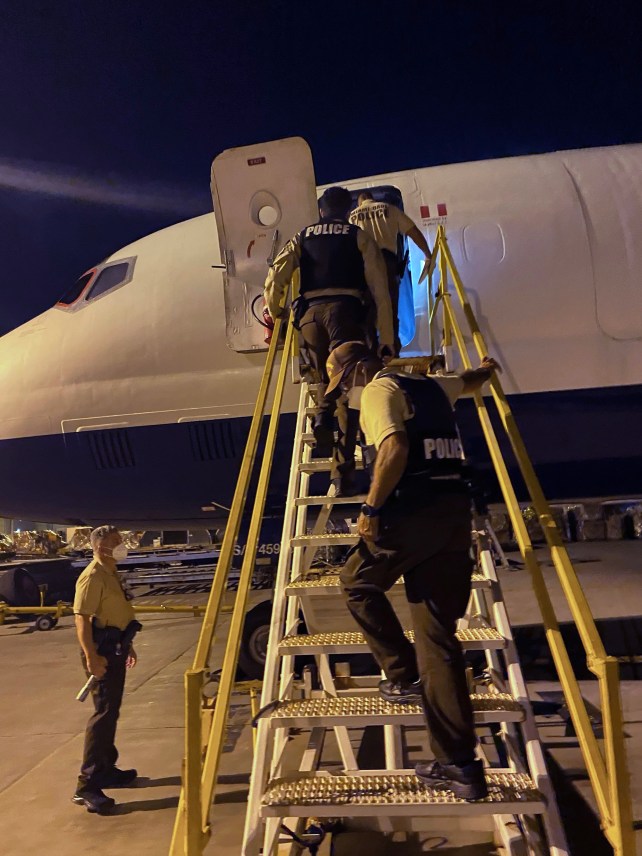
Law enforcement seizes a Skybus plane in Miami.
Courtesy Matt Block
Worldwide Primates is still in operation today, importing for, among other clients, the US government and more specifically the NIH. And while Block says his logistics business hasn’t been directly impacted by the monkey shortage (sourcing animals is “up to the individual client,” he notes), those clients are feeling the pressure: Every country that’s a major player in primate research has felt the impact on some level, Block tells me.

Today’s primate shortage has been years in the making. According to a 2018 NIH report on the country’s nonhuman primate usage, the number of monkeys expected to participate in experiments grew from about 4,500 in 2013 to about 8,200 in 2016, and 6,400 in 2017, based on grants awarded for those years. (A big reason for the increase, the report notes, was funding for HIV/AIDS research.) But the report also looked to the future, estimating that demand—even before Covid—would increase in the coming years, particularly for rhesus macaques. For that species alone, scientists planned to use about 8,000 animals per year from 2018 to 2022.
But as the number of primates to be used for science vastly expanded, funding to actually breed and house animals at the seven primate centers remained flat, multiple directors tell me. “Most years,” says Wisconsin primate center director Jon Levine, “I can say with confidence that the [National Primate Research Centers] barely meet, or are unable to meet in a timely manner, all requests” for primate research. “We have been chronically receiving no increases in our budgets, or very modest increases in our budgets, for over 20 years.”
As a result, according to the 2018 report, about half of researchers working with monkeys said they were experiencing problems with obtaining animals or “related research services” that caused them to delay or change the design of their studies, or influenced how those studies were performed. Due to “infrastructure limitations” and the amount of time it takes to grow colonies, the report said, “the current NIH-funded centers and colonies may not be able to satisfy the predicted increase in demand for rhesus macaques and marmosets for at least the near term.” (There is “a long lead time,” the report noted, between when a monkey is born and when it’s ready to be studied, meaning that even if the government increased domestic breeding, it’d still take years for researchers to see the benefit of it.)
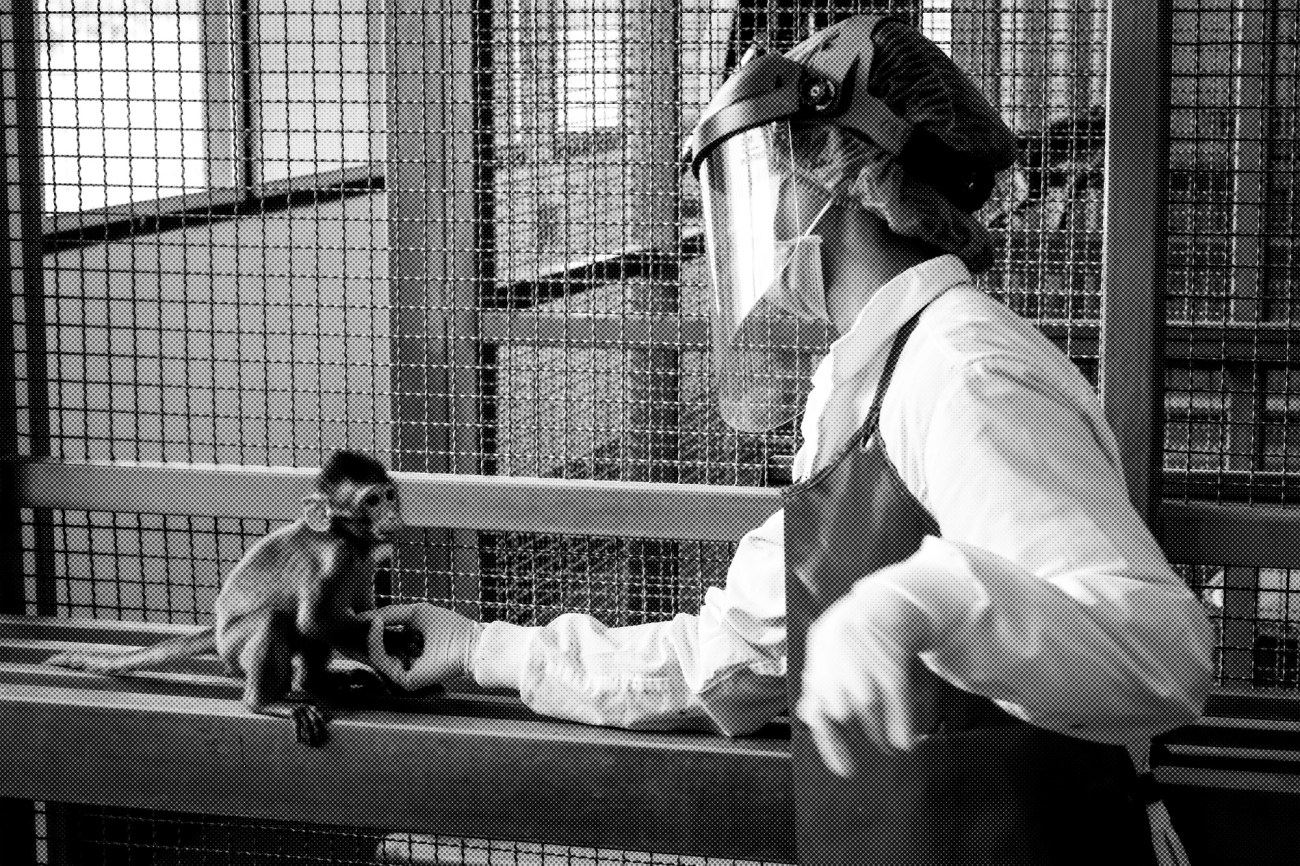
A baby monkey interacts with a laboratory employee in the breeding center for cynomolgus macaques, also known as long-tailed macaques, at the National Primate Research Center of Thailand.
Mladen Antonov/AFP/Getty
Then, in late 2019, ignoring its own report, the Trump administration imposed a 15 percent tax on many Chinese goods, including monkeys, as part of the former president’s trade war. At the time, China was the United States’ biggest supplier of primates, and advocates for animal testing warned the tariff could “severely damage” medical research in the US. “The proposed tariff would hand China an even greater cost advantage, which will incentivize many researchers to conduct studies in China instead of the United States,” Bailey, of NABR, reportedly wrote in a letter to then–US Trade Representative Robert Lighthizer.
Their fears didn’t take much time to bear out. As the Atlantic’s Sarah Zhang has reported, shortly after the pandemic hit in early 2020, what was already a strained and expensive supply line effectively ceased to exist: China stopped exporting monkeys altogether, opting to conserve them for its own research, experts speculated at the time. Between December 2019 and February 2020, total US imports dropped from about 3,400 monkeys per month to 1,400 in January, and about 870 monkeys in February—just as the pandemic was setting in.
By the fall of 2020, monthly monkey imports had returned to their 2019 levels, thanks to large increases in supply from Cambodia and Mauritius—and since have largely stabilized. And last year, despite zero monkeys coming from China, the US managed to import more than 31,000 monkeys in total, just 8 percent less than imports in 2019. But this has hardly meant a return to normalcy in the US. Keep in mind that while the total number of imports may have recovered, the entire world is fighting a pandemic. On top of the demand for studying HIV, or malaria, or cancer, or an endless number of other research areas, two years ago a never-before-seen virus swept across the planet. And we needed monkeys to fight it.

For the national primate centers, the pivot to Covid research didn’t happen overnight. “We weren't planning to do any experiments for SARS-CoV-2 because we didn't know about it,” Haigwood, from the Oregon primate center, tells me from across a conference table in her large, glassy office. “And we have ongoing research. We have demands for monkeys, and we had planned carefully, exactly what we would do.”
What the Oregon center could do to quickly fight the coronavirus, however, was supply monkeys. When Covid hit, Haigwood’s center sent 100 monkeys to NIH labs that were conducting the most immediate studies into the then-novel coronavirus. But it came at a cost: “That hurt us,” she says. “Those are 100 monkeys that we'd love to have right now. But they all got used for Covid research.”
Eventually, Oregon got in the Covid game, too. During my visit last August, for instance, Haigwood had plans to test an aerosol-based spray that would administer monoclonal antibodies, which have been shown to help prevent hospitalizations in high-risk Covid patients. But at the time, her center still didn’t have any monkeys to spare for the experiments. “I need animals in December,” she tells me then. “And I don't know whether I'm going to get them…People are waiting six months or longer to start their studies, because we’re waiting for animals literally to grow.” (When I follow up in June, I am told that the Oregon center was able to assign animals “in a timely manner” to the study, and "lab analyses" are still ongoing.)
The California primate center, located in Davis, has been facing similar pressures. Since the onset of the pandemic, associate director of primate services Jeffrey Roberts tells me the center has seen more requests for monkeys from outside researchers than they can meet: “We don't have animals available for them.” For fields outside of Covid, like Alzheimer’s, Parkinson’s, and heart disease, the low monkey supply has been “devastating,” Roberts adds. Similarly, the Southwest center, which is affiliated with the Texas Biomedical Research Institute in San Antonio, houses “one of the smallest colonies of rhesus macaques,” leaving its researchers “extraordinarily impacted” by the shortage, says Kaushal, its director. “We're telling people, core scientists, myself included, that you can't get animals assigned to your projects because they're just not high priority enough.” Kaushal’s work on tuberculosis, for instance, is one of the areas that hasn’t made the cut.
Researchers at smaller academic institutions, without direct access to the national primate centers, have felt the shortage on a different, arguably deeper level. Take the work of Sally Bernardina Seraphin, a primate behavioral neuroscientist at Trinity College: When she was a graduate student at the Yerkes National Primate Research Center at Emory University about 20 years ago, she studied how stress in early life may be related to brain function, including addiction and motivation. “If there continues to be a shortage, I will never be able to go back and address those questions,” she tells me, hypothetically speaking. That's a problem not just because the research is valuable, she says: “It's a problem because I'm one of the first people of color who are addressing these kinds of questions.” A Haitian American and daughter of immigrants, Seraphin says her work isn’t “arbitrary exercises”; it’s personal. “I come from a family where there is a legacy of trauma that has impacted mental health and well-being over several generations,” she says. “That is the burden that I bring, and the urgency that I bring to questions about early life experience.” She notes that researchers who are people of color, queer, or earlier in their careers are already less likely to receive large government grants, and are potentially most vulnerable to the shortage.
Private companies have also been hard hit. One researcher at a pharmaceutical company tells me that more and more often, scientists are having to make difficult decisions about which drugs get tested. (She asked to remain anonymous due to a concern that her company wouldn’t allow her to talk to the media.) As she explains, her company might see 10 promising compounds in its pipeline but must limit monkey studies to treatments with the highest chances of success. And if a given condition already has some treatments available, new drugs for that condition may get put on the backburner. “Nobody has enough resources to do all the stuff they would ever want to do,” she says. “But it’s becoming much more challenging.” She declined to share specifics, citing the desire to protect “proprietary company information,” but notes that drugs that may help treat cancers, including brain cancer, and “some neurologic conditions” have been put on hold.
(Covid vaccine makers Moderna and Johnson & Johnson did not respond to my interview requests, and Pfizer declined, pointing me to the National Association for Biomedical Research.)
Beyond the hit to research, experts also warn that the lives of animals have been impacted by the shortage—bringing to the fore increasingly thorny ethical questions. Animals arriving from overseas, the private pharmaceutical researcher observes, are not as “robust” as they were in previous years. “I believe animals are being shipped that probably would not have been sold in the past,” she says. “They're perhaps a bit weaker, a bit more fragile animals.” They’re also arriving younger, forcing researchers to decide between delaying their studies—or experimenting on adolescent animals.
According to Mark Lewis, the president and CEO of Bioqual, Inc., an organization that performs research on behalf of pharmaceutical companies, it’s become common practice to “repurpose” animals from previous studies. “It's a finite resource,” he says. “And to get new animals—they're quite expensive.” This was particularly true at the beginning of the pandemic: Lewis, whose company has conducted Covid research with Moderna, AstraZeneca, Regeneron, and Johnson & Johnson, estimates that in the first nine months of 2020, the majority of coronavirus-related research on primates in the US relied on recycled animals. (Bioqual, for instance, tapped into its supply of rhesus macaques that were not challenged with virus in HIV trials.) But, he says, even those monkeys disappeared quickly.
Lewis’ company was then forced to look elsewhere: It connected with a primate broker who could supply another species, long-tailed macaques, from Southeast Asia and—like with International Logistics Support—Mauritius. “We've been lucky,” he says. But those monkeys didn’t come cheap: As demand increased under Covid, “the costs probably went up at least 50 percent,” he says. “And it's been creeping up ever since.” And now, he says, rhesus macaques are “virtually impossible to get, except for HIV research.”
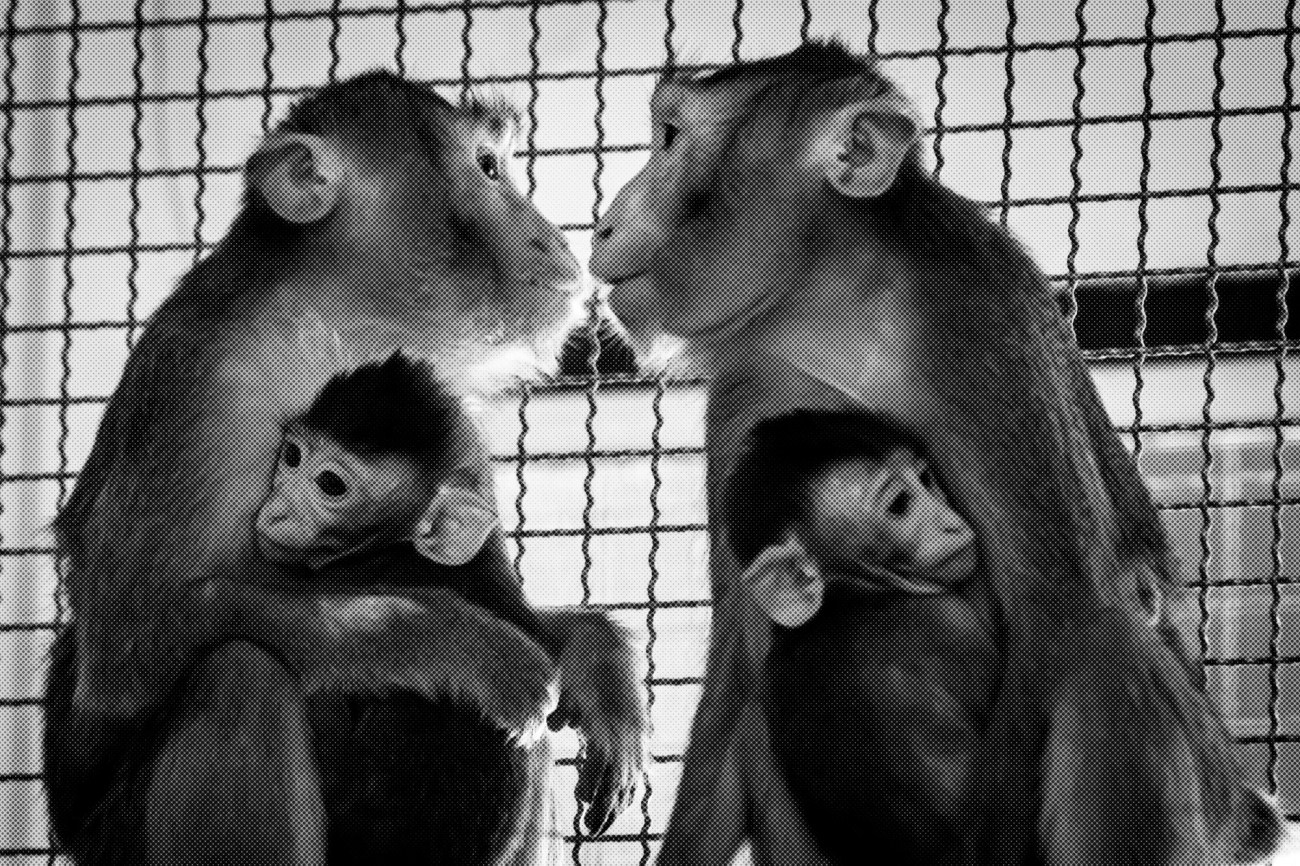
Long-tailed macaques sit with their babies in their cage in the breeding center at the National Primate Research Center of Thailand.
Mladen Antonov/AFP/Getty
As the supply chain has tightened, some experts suspect the global demand for primates has contributed to the illegal capture and sale of wild monkeys, too. According to a 2021 study from an international coalition of researchers, between 2008 and 2019, at least 450,000 long-tailed macaques and more than 700,000 “specimens” (that is, samples from monkey tissue or blood) were traded globally. Of that, 50,000 were reported to be caught from the wild. This is likely an undercount, according to the authors, in part because it doesn’t account for wild animals that have been laundered as captive-bred. The pandemic isn’t helping: With China closing off exports, “the US, the UK are scrambling globally to Indonesia, Vietnam, a variety of places to try to get [monkeys],” says Agustín Fuentes, an anthropologist at Princeton University and an author on the study. “And those places have a long history of, let’s say, fudging the reality of captive versus wild-caught.” With just 3 million long-tailed macaques estimated to live in Southeast Asia in the early 2000s, the level of trade we’ve seen in recent years is “likely not sustainable,” the study’s authors conclude.
It gets worse: As Fuentes points out, the more that humans tap into wild primate populations, the more we put ourselves at risk of another virus jumping from mammals to humans: “As we’re increasing the amount of wild capture of these macaques,” he warns, “we’re radically increasing the chances for more viral jumps and pathogen instances.”

It only took a year of reporting, but it’s with this context that Block’s failed flight finally started to make sense to me. For years, the entire industry had been tasked with answering crucial scientific questions, with limited tools to do so. Then the pandemic hit, which, as Bioqual’s Lewis tells me, “changed everything.” With demand as high as it is, the entire field isn’t operating as it should. And the canceled flight is just one telling scene in a sprawling shitshow.
In an ideal world, we wouldn’t need research monkeys to begin with, let alone more of them. Over the years, there have been some propositions of alternatives, including computer modeling or lab-grown organs. These technologies are out there, and in some cases have indeed reduced the need for animal models. Consider, for instance, that before the vehicle crash dummy, scientists often relied on animals, including pigs and dogs, in crash testing. Or, in 2016, researchers were able to model the effect of Zika on fetal brain development by exposing lab-grown mini-brains to the virus. They found that these organoids, as they’re called, were about 40 percent smaller after being exposed to the virus—an observation that otherwise may have required testing in animals. Similarly, scientists have grown in labs tiny lungs, kidneys, and livers, among other organs, and infected them with Covid in an effort to understand how the virus infects our bodies.
But in many cases, experts say, these substitutes are rudimentary, and still don’t come close to the real deal. And some research, say, gene-editing embryos or performing brain cell grafts, can’t always be tested in humans, at least not ethically. “If there was a way to do [pharmaceutical studies] without animals,” the private pharmaceutical researcher says, “it would be very cost effective for us to not do that. The fact is, we do this because it's necessary for the science.”
With few alternatives, primate researchers say the best way to dig out of the shortage, at least for now, is to increase domestic monkey supply. If we can build out our monkey colonies in the US, they say, there’d be less of a need to import animals from abroad. But to totally revamp infrastructure and breeding capacity at the NIH-funded primate centers will take cash, to around the tune of $50 million, estimates Kaushal, director of the Southwest primate center. That’s on top of the “base grants” provided annually by the NIH to “to maintain the buildings and the facilities, keep the lights on, keep the water running,” he explains.
Biden’s 2022 spending bill, which Congress approved in March, originally included $30 million in NIH funding for expanding infrastructure at the national primate centers, but for reasons unknown to the people I spoke with, those funds were cut from the budget. “We were very disappointed to see that it was not included in the end,” Kaushal says. (In an email, the NIH notes that it was granted $70 million by Congress to support biomedical research and infrastructure, some of which could be used for the primate centers. “We are currently in the process of reviewing grant applications to make awards using these funds,” the NIH says.)
If researchers want to see more cash, it might help to speak up. Several experts I interviewed for this story agree that educating the public—especially leaders in Congress—about primate research may help with their funding issue. As NABR’s Bailey puts it, “I think raising awareness about the nonhuman primate shortage increases the odds that support will gather for providing either funding or other policy solutions to address the problem.” The trouble is, many researchers remain reluctant to do so—and the idea of a shadowy research underworld persists.
Haigwood is a notable exception. Despite death threats, harassment, and vandalism targeting Haigwood and her Oregon center colleagues, she remains a leading voice in favor of primate research. Her work, which she is open about, focuses on preventing AIDS infections in children born to HIV-positive mothers. It often involves infecting monkeys with an HIV-like virus, a practice that is unlikely to ever be approved for human trials. But it can be done in monkeys—and only monkeys; HIV doesn’t replicate in other animal models, she tells me.
During my visit, there is one area with live animals that Haigwood does agree to show me: the “corn cribs,” a line of gazebo-shaped breeding pens, nicknamed for their resemblance to the agricultural storage bins. Each of the cages hold about 15 rhesus macaques, typically a “harem” consisting of one male adult, a handful of adult females, and their offspring.
As we approach, the monkeys turn to face us. Some jump up and cling to the side of the enclosure, others line up to look at us from a perch. As we stand and observe from a safe distance of what I estimate is about 20 feet, many of the monkeys snack on strawberries scattered on the floor of their cages. (Among options of strawberries, blueberries, mushrooms, and Brussels sprouts, I am told blueberries are the favorite.) Some of the monkeys have names.
After the visit, I can't stop thinking that it felt a lot like a zoo, minus the tourists and the greasy café food. There is no giftshop. And instead of dying in their outdoor enclosures, old and wrinkled, many of these animals would eventually move to a lab to die. Maybe their tissues would be preserved in freezers for future research. Maybe they’d help cure Alzheimer’s, or AIDS, or fight the next pandemic. Maybe their offspring would. In any case, their deaths would be in service to science—to us. As long as we keep dying, for the foreseeable future at least, they would, too.

